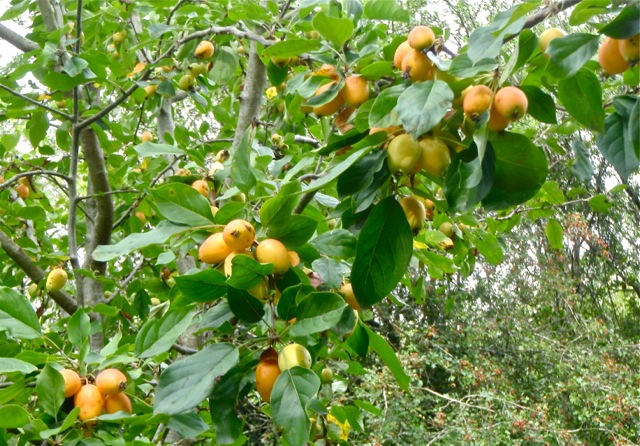After the excesses of August, September 2020 was a more predictable month, mostly warm and humid with fewer stresses on wildlife. Fruits ripened and some leaves showed the first signs of autumn.
The 2nd was bright, breezy and warm, with a green woodpecker calling loudly, a Southern Hawker dragonfly patrolling the banks, many Speckled Wood butterflies in dappled shade, robins, chiffchaffs, house sparrows calling, with dunnock, blue and great ts and nuthatches seen and heard. The 5th was cooler and cloudier with nuthatches increasingly vocal and Migrant Hawker dragonflies now more numerous. These are smaller and less brightly coloured that the Southern Hawker.
Crab Apple tree laden with fruits which will later turn bright orange and attract many birds. Sometimes the ripe crop can disappear within a day, eaten by newcomers flying in.
Further north another Crab apple variety we planted yields an entirely different crop, late, the fruits serving wildlife in the depths of winter.
The following day was fine, sunny and cool, with Red Admiral butterflies , Large Whites and Speckled Woods seen. Two juvenile blackcaps were very clearly seen contact calling on their way along the river bank thickets together with blackbirds, robins and wrens, and the ever present and lively house sparrows were preening in the sun and eating ripe blackberries.
The evening of the 6th was very memorable with a Bat Survey carried out in the evening:
Starting out slightly earlier than usual with good insect conditions, around 16degsC, a light breeze SSW, dry but with clouds moving slowly over the sunset, heading south first I immediately encountered Common Pipistrelle bats with two Soprano Pipistrelles flying quite high up , about 5 meters, amongst grown trees and riverbank trees. These bats were seen against the sky as it was not yet dark, but cloudy. Looking up from under an old Oak, I saw a grey heron sitting high on a branch, looking down at the river. Was this its evening roost? On the way back there were many more bats, becoming less visible but very audible using the Bat Detector. Suddenly the numbers of very low flying bats increased and it became evident that the bats were weaving around the embankment fruit trees where early windfalls were attracting huge numbers of insects. It had quickly become dark but the bats were easy to detect.
The second week in September was mostly warm and humid with adult mallard ducks progressing slowly along the river, unseen under the banks. Moorhens gave their characteristic calls, giving away their presence. Abundant insects attracted more warblers - chiffchaffs and blackcaps along the river and good numbers of blue and great ts, flying amongst the young trees, just growing to the right size to encourage low-nesting birds. Chiffchaffs especially, together with some common whitethroats in the spring. A spotted flycatcher was perching on a rather bare small tree in the middle of the field, with a Migrant Hawker ranging the periphery. A Common Blue butterfly was also seen near some ants nests.
The third week in September became hotter again with an oppressive haze and very slight NE breeze. Blackbirds were still obviously moulting and few birds were singing. The ground again became very dry on the surface with birds seeking the damp shade. House sparrows however thrived in the heat and were seen 'spidering' each morning as soon as the sun reached the branches. On 20th a Brown Hairstreak female butterfly was ranging along a path, seeking out the nearby Blackthorn branches along the river bank. It gave good views as it perched on a dead leaf near the ground before flying up to the Blackthorn.
Towards the end of September, grey herons were seen more frequently flying to and from their roosts and river feeding grounds holding small fish and amphibians. Red Admiral and Speckled Wood butterflies and Migrant Hawker dragonflies were still quite common, with our local resident birds - bullfinches - heard calling occasionally. Blackcaps were still present on the last day of the month. Pied wagtails were now passing through across the river, perching on rooftops with sightings of a few meadow pipits too.
A survey for 28th September follows in the next post...

No comments:
Post a Comment